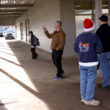Sean C. Morgan
The Sweet Home Fire and Ambulance District Budget Committee last week approved a budget recommendation that includes a 6.25-percent increase in spending – $133,600.
The proposed budget will increase from $2.134 million to $2.267 million, from 2010-11 to 2011-12.
Four main factors contributed to the increase, said Fire Chief Mike Beaver. First is a 4-percent increase in the district’s contribution to the Public Employees Retirement System; the district taking out a $250,000 line of credit instead of a $200,000 tax anticipation loan; a 16-percent increase in health insurance premiums; and a 17-percent increase in dispatch costs.
As a result, along with cost-of-living raises, personnel costs are increasing by $98,000 to $1.287 million. With the line of credit, debt service increases by about $47,500.
Increases are offset by about $28,300 in contingency funds, leaving an unappropriated ending fund balance of $150,000.
Revenues include a cash carryover of about $235,000, down from $356,000; $1.15 million in property taxes, $575,000 in Firemed fees and $250,000 in tax advance loans.
The district’s administrative division, including the fire chief, battalion chiefs and administrative assistant will cost $1.16 million, up from $1.09 million.
The ambulance division, with six paramedic-firefighters and six intern medics, will cost $926,000, up from $855,000.
The fire division will cost $179,000, down from $184,000.
The district is including $5,000 for narrowband radio equipment, Beaver said. The district is required to be narrowband compliant by January 2013.
All eight Linn County fire departments and Linn County Sheriff’s Office will share in upgrading the old wideband radio equipment, a $125,000 project. Fire districts are paying their portion of the costs interest free in two annual installments to the Sheriff’s Office.
The radio change-over is a result of a Federal Communications Commission edict that, as stated on the FCC website, by Jan. 1, 2013, all public safety and business industrial land mobile radio systems operating in the 150-512 MHz radio bands cease operating using 25 kHz efficiency (wideband) technology, and begin operating using at least 12.5 kHz efficiency (narrowband) technology.
The deadline is the result of an FCC effort that began almost two decades ago to ensure more efficient use of the spectrum and greater spectrum access for public safety and nonpublic safety users. The use of narrowband radio frequencies increases the number of usable frequencies and reduce frequency congestion.
Purchasing a new ambulance is a priority next budget year, Beaver said. The newest ambulance, a 2007 Braun, has more than 100,000 miles on it. The oldest ambulance, a 2002 model, has 113,000. The district reserves $65,000 per year to pay for equipment and ambulances.
The state of the district’s fire apparatus and associated equipment is the best in the department’s history, Beaver said. That has helped the district maintain an insurance rating that equates to lower insurance rates around the community as a whole.
“The current downturn in the economy has had a negative impact on this district as well as all public agencies,” Beaver said. “We have experienced a slight downturn in ambulance call volume as well as decreases in fees for service from Medicare and other insurance companies.”
So far this year, the district is running ahead of last year’s call volumes, Beaver said. “If that stays consistent throughout the year, it may equate into more ambulance revenue.”
Like other agencies, the low revenue growth and poor economy are major challenges, Beaver said, but they are not new for the district personnel, who are accustomed to functioning through adversity.
“Several things that we can’t control seem to dominate our budget increases each year,” Beaver said. “New government mandates, retirement and healthcare costs being three of the biggest hurdles.
“Despite the downturn in our economy, needs and requests from Sweet Home’s citizens continue to increase. It’s our responsibility to meet those needs with less financial resources for the time being. The public won’t respond positively to a reduction in services. Our job is to maintain a well-trained staff to continue providing the best customer service possible.”
The budget moves next to the district Board of Directors for adoption prior to June 30. The new fiscal year, 2011-12, begins on July 1.




